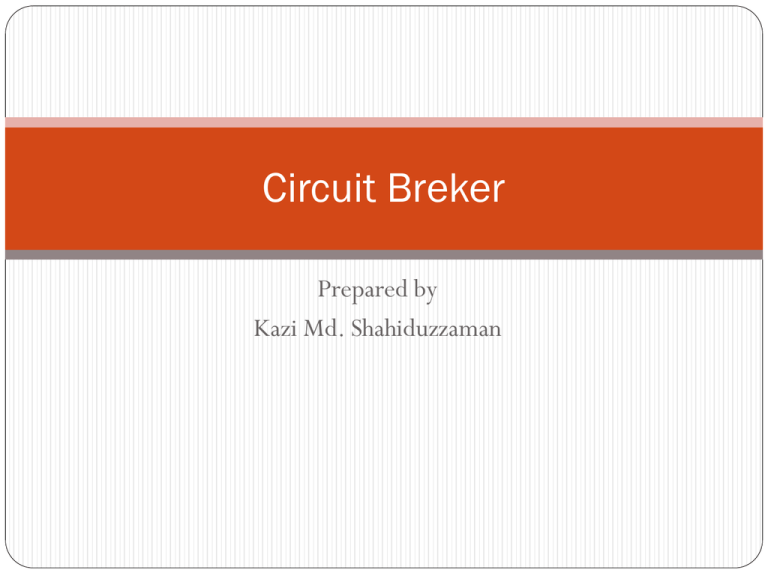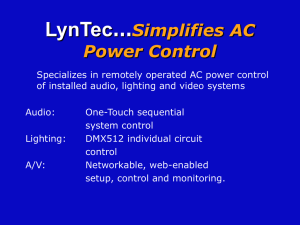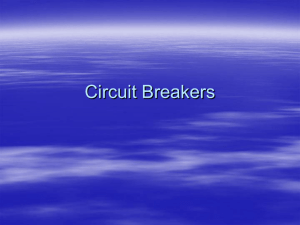Prepared by - nubacad.com
advertisement

Circuit Breker Prepared by Kazi Md. Shahiduzzaman Outline of this Chapter Definition of Circuit Breaker Technical Particulars of Circuit Breaker Working principle of Circuit Breaker Classification of Circuit Breaker Arc phenomenon and it’s principle of Extinction Methods of arc extinction Some important terms Rate of rise of TRV Circuit Breaker Rating Circuit Breaker A circuit breaker is a piece of equipment which can (i) make or break a circuit either manually or by remote control under normal conditions (ii) break a circuit automatically under fault conditions (iii) make a circuit either manually or by remote control under fault conditions Technical particulars Circuit Breaker • Type of medium for arc- extinction. •Rated voltage • Structural form • Rated breaking current • Type of operating mechanism • Type of construction • Total Break time Working Principle of Circuit Breaker A circuit breaker essentially consists of fixed and moving contacts. Under normal operating conditions, the contacts remain closed and the circuit breaker carries the full-load current continuously. When a fault occurs, the resulting overcurrent in the C.T. primary winding increases the secondary e.m.f. This energises the trip coil of the breaker and moving contacts are pulled down, thus opening the contacts and hence the circuit. When the contacts of a circuit breaker are separated under fault conditions, an arc is struck between them. The current is thus able to continue until the discharge ceases. Classification of Circuit Breaker The Circuit Breaker can be divided according to the arc extinction medium into the following categories: Axial Blast Air Break C.B Air Circuit Breaker Circuit Breaker Oil Circuit Breaker SF6 Circuit Breaker Vacuum Circuit Breaker Air Blast C.B Cross Blast C.B Bulk oil C.B. Radial Blast C.B Low oil Circuit Breaker Arc Phenomenon At the instant when the contacts of C.B. begin to separate, the contact area decreases rapidly and large fault current causes increased current density and hence rise in temperature. The heat produced in the medium between contacts (usually the medium is oil or air) is sufficient to ionise the air or vapourise and ionise the oil. The ionised air or vapour acts as conductor and an arc is struck between the contact. The arc resistance depends upon the following factors : Degree of ionisation (ii) Length of the arc (iii) Cross-section of arc (i) Principle of Arc Extinction The factors responsible for the maintenance of arc between the contacts are: (i) p.d. between the contacts (ii) ionised particles between contacts Methods of Arc Extinction There are two methods of extinguishing the arc in circuit breakers viz. 1. High resistance method. 2. Low resistance or current zero method High resistance method: In this method, arc resistance is made to increase with time so that current is reduced to a value insufficient to maintain the arc. Consequently, the current is interrupted or the arc is extinguished. The resistance of the arc may be increased by : (i) Lengthening the arc (ii) Cooling the arc. (iii) Reducing X-section of the arc (iv) Splitting the arc The principal disadvantage of this method is that enormous energy is dissipated in the arc. It is employed only in d.c. circuit breakers and low-capacity a.c. circuit breakers Low resistance or Current zero method: This method is employed for arc extinction in a.c. circuits only. In this method, arc resistance is kept low until current is zero where the arc extinguishes naturally and is prevented from restriking inspite of the rising voltage across the contacts. All modern high power a.c. circuit breakers employ this method for arc extinction. A.C. arc interruption is to rapidly deionise the medium between contacts as soon as the current becomes zero so that the rising contact voltage or restriking voltage cannot breakdown the space between contacts. The de-ionisation of the medium can be achieved by: Lengthening of the gap High pressure Cooling Blast effect Important terms ArcVoltage: It is the voltage that appears across the contacts of the circuit breaker during the arcing period. Restriking voltage: It is the transient voltage that appears across the contacts at or near current zero during arcing period. • Recovery voltage: It is the normal frequency (50 Hz) r.m.s. voltage that appears across the contacts of the circuit breaker after final arc extinction. It is approximately equal to the system voltage. Thank you









